White sturgeon, also known by their scientific name Acipenser transmontanus, is a sturgeon species in the Acipenseridae family. The largest white sturgeon ever caught in California was nearly 500 pounds.
They’re an anadromous species that live in the Pacific Ocean but migrate to freshwater bodies to spawn.
White sturgeons’ habitat ranges from Monterey, California, to the Gulf of Alaska. But some are landlocked in Lake Shasta in California and the Columbia River Drainage in Montana. Some have also been sighted in Baja, California, in Mexico.
The Largest White Sturgeon Ever Caught in California
Before the 1900s, many giant white sturgeon were caught, but size records were vague. But the largest of them was over 13 feet long and weighed over 1300 lbs., making white sturgeon the largest freshwater fish in North America. The fish’s age was estimated to have been 100 years.
According to California’s official fishing records, Joey Pallotta, III, caught the largest white sturgeon ever in the history of California.
Pallotta, a resident of Crocket, California, caught the 468-pound (212.48 kilograms) fish at San Pablo Bay in Contra Costa County on July 9, 1983. The freshwater angler caught the fish through a lure, a live grass shrimp.
Pallotta’s catch is also the biggest freshwater fish ever caught on rod and reel.
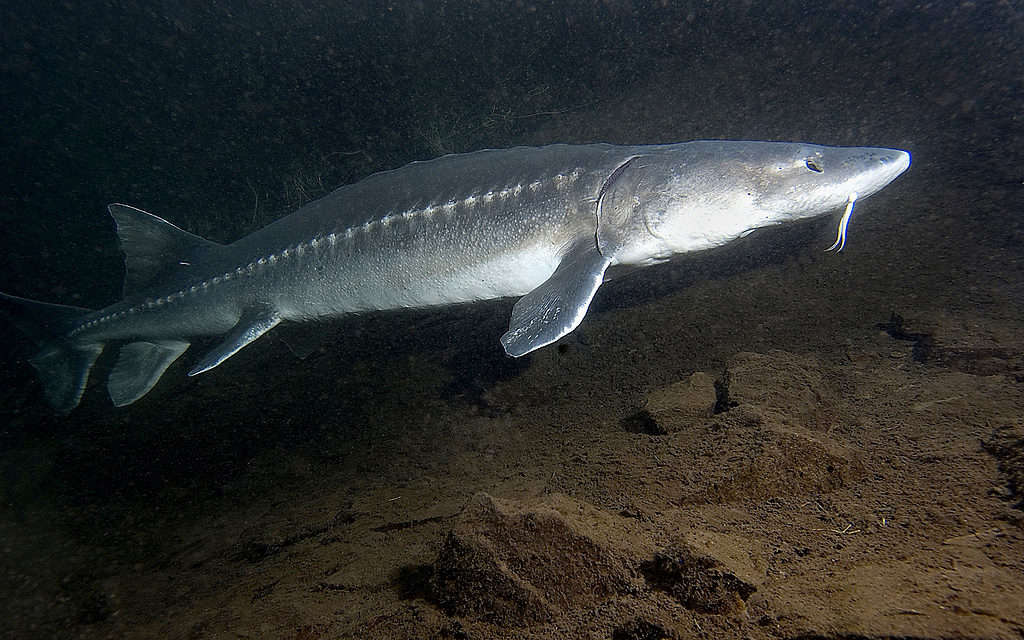
©Oregon Department of Fish & Wildlife, CC BY-SA 2.0 <https://ift.tt/Lw8j2UW>, via Wikimedia Commons – License
The Largest White Sturgeon Ever Caught Worldwide
The largest white sturgeon ever caught worldwide was 10 feet 4 inches long. Greg Poulsen and Angie Poulsen caught the monster fish at the C.J. Strike Reservoir in Idaho on August 5, 2022. The reservoir is known for its abundant smallmouth bass and crappie.
The Poulsens, Eagle Mountain residents, had traveled to Idaho, hoping for an encounter with the largest freshwater fish in North America.
At 124 inches long, Poulsen’s catch beat the previous record set by Rusty Peterson and friends in 2019.
About White Sturgeon
White sturgeon are a fascinating fish species with unique attributes well-adapted to their environment.
Appearance
White sturgeon has a long, cylindrical body well-adapted for life in fast-flowing rivers and estuaries. The fish can grow up to 20 ft. long and weigh over 1,500 lbs., making them one of the world’s largest freshwater fish.
Additionally, this fish’s exterior is covered in bony scutes that protect it from injury and help it move through the water. Finally, the fish’s mouth is large and as no teeth, allowing it to suck in food from the water.
Characteristics
The white sturgeon is long-lived, with an average lifespan of 60-80 years. It grows slowly, taking many years to mature. But once mature, it grows quickly, adding several inches to its length yearly.
White sturgeon are migratory fish traveling long distances between spawning and feeding grounds. For example, in California, they migrate from the ocean into rivers in the spring to spawn but return to the ocean in the fall to feed.
Importance to the Ecosystem
As keystone species, white sturgeon help maintain their ecological balance. They prey on large amounts of smaller fish and other aquatic life, helping to control the populations of the species. White sturgeon, therefore, prevent overpopulation and preserve the ecosystem.
Additionally, white sturgeon are an important part of the food chain. They’re preyed upon by many larger predators, including humans, seals, and many birds of prey. They’re also important prey for smaller predators, such as bass and catfish, helping to support the survival of these species.
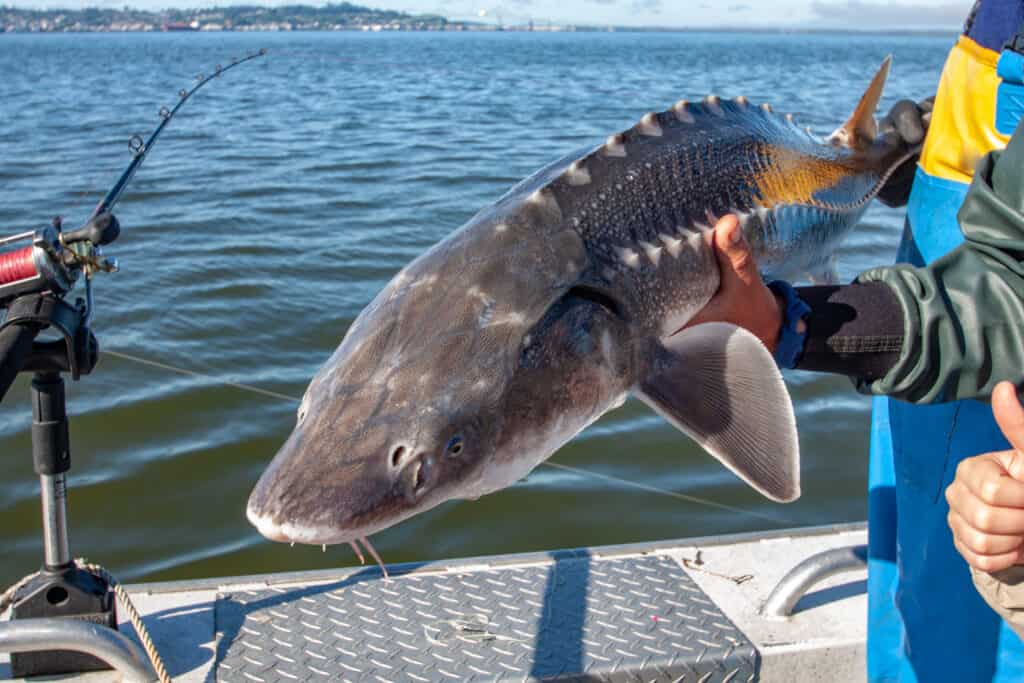
©CSNafzger/Shutterstock.com
White Sturgeon in California
White sturgeon are essential in California’s aquatic ecosystem. Besides, they’re highly valued by anglers and visitors to the state’s waterways.
Population and Distribution
Native to North America’s pacific coast, white sturgeon can be found in California’s rivers and estuaries, including San Joaquin and Sacramento rivers. However, this fish’s population has declined over the years due to habitat loss and overfishing, among other factors.
Regardless of these challenges, California still boasts healthy white sturgeon populations. Therefore, it is a popular sturgeon fishing location.
Sturgeon Fishing in California
Sturgeon fishing is a popular recreational activity in California, with many anglers across the world coming to experience it.
If you’re a fan of sturgeon fishing, visit the state’s waterways between December and May when the fish are closer to the shore for spawning. You can use several methods to catch the fish, including:
- Bait fishing
- Fly fishing
- Bow fishing
Popular fishing spots in the state include:
- Sacramento River
- San Joaquin River
- Suisun Bay
Regulations and Conservation Efforts
California State’s Department of Fish and Wildlife has put in place several rules to ensure the long-term survival of white sturgeon in the state.
For example, the state follows size limit rules; only fish over a certain length can be harvested. Moreover, the state has a strict quota system that limits the number of sturgeon caught yearly. The department also conducts regular research and monitoring to better understand the sturgeon’s needs and ensure their continued survival.
These conservation efforts and regulations are vital for the survival of white sturgeon in California. Therefore, anglers and other stakeholders must support the efforts and follow these rules.
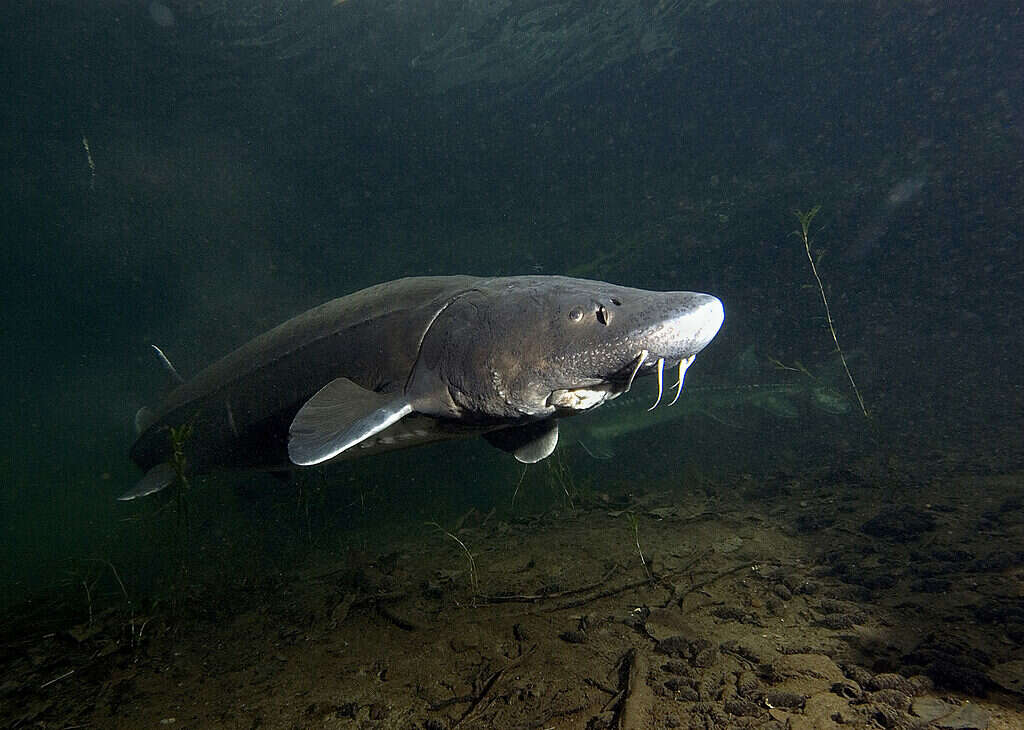
©Oregon Department of Fish & Wildlife, CC BY-SA 2.0 <https://ift.tt/Lw8j2UW>, via Wikimedia Commons – License
White Sturgeon’s Diet
White sturgeon are opportunistic feeders. Therefore, they’ll eat whatever food is available around them. Depending on what is available and what is the most energy-efficient source of food, they have been known to consume both plant and animal matter.
Common White Sturgeon Prey
Some of the common prey for this fish include the following.
- Small fish. Herring, sand lance, and anchovy are some of the small fish that white sturgeon prey on.
- Crustaceans. They also eat crustaceans like crabs, shrimp, and crayfish.
- Mollusks. They also consume mollusks like clams and mussels.
- Aquatic insects. White sturgeon also eat aquatic insects, including dragonflies, damselflies, and mayflies.
- Larger prey (fish and squid). As they get bigger, white sturgeon may eat larger prey, including other fish and squid.
How White Sturgeon’s Eating Patterns Change As They Mature
It is well known that white sturgeon feed more frequently when they are young and less frequently as they age.
Additionally, they grow from eating smaller prey to larger ones as they get bigger.
A Sluggish Metabolism and Irregular Eating Habits
These fish don’t require frequent feeding because of their slow metabolism. However, when they do feed, they can eat a lot. This is because they can store nutrients and energy in their bodily tissue, which enables them to go for long periods without eating.
Breeding
White sturgeons reproduce through a process known as spawning. In this process, the male releases his sperm to fertilize the eggs earlier released into the water by the female.
This usually happens in river systems where the species dwell in late winter or early spring. Then, the eggs undergo fertilization, grow into larvae, and mature into young sturgeons.
The Breeding of White Sturgeon: Influential Factors
Several variables influence the success of white sturgeon reproduction. Water velocity and temperature are two crucial elements.
Rivers with warmer water temperatures might not be good places for this fish to reproduce because their ideal breeding temperature ranges from 50 to 55 degrees Fahrenheit. The river’s flow can also impact the ability of the eggs and larvae to survive and thrive.
In addition, it’s crucial to consider habitat and water quality. To properly reproduce, white sturgeons require clean, healthy rivers with ample food. Pollutants, including chemicals and heavy metals, can harm these fish, therefore, affecting their reproductive capacity.
Obstacles to Successful Breeding of White Sturgeon
Unfortunately, white sturgeons face several challenges to successful reproduction.
Recent years have seen a dramatic decline in white sturgeon numbers due to overfishing and habitat destruction. White sturgeon reproduction and survival are also threatened by pollution and climate change. Therefore, it is crucial to act to address these problems since they make it more difficult to preserve and safeguard these fish populations.
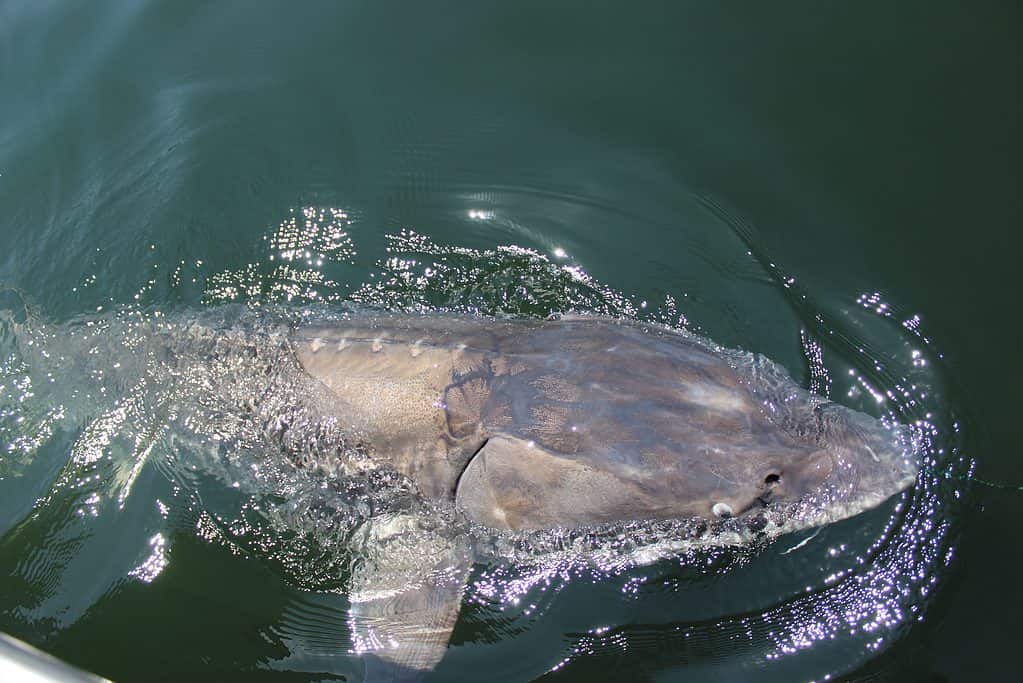
©Leah.Zastrow/Shutterstock.com
Threats to White Sturgeon Populations
White sturgeon face numerous threats, putting their already dwindling populations at risk. Some of these threats include:
- Overfishing
- Habitat destruction
- Introduction of non-native species into their habitat
- Climate change
Let’s take a closer look at each of these threats.
Overfishing
Overfishing is a serious concern for this fish. The demand for their caviar and meat has led to overfishing, therefore, severely impacting the populations.
White sturgeon are particularly vulnerable to overfishing because they are slow-growing and slow-reproducing. Consequently, their populations take much longer to recover.
Habitat Destruction
Another major threat to this fish is the destruction of their natural habitats. Several human activities have negatively impacted white sturgeon’s natural habitats—estuaries and rivers. Some of these activities include:
- Dam construction
- Water diversions
- Pollution
Therefore, the destruction has made it difficult for white sturgeon to find food, reproduce, and thrive.
Introduction of Non-Native Species
Introducing invasive species into rivers and estuaries, white sturgeon’s natural habitats threaten their populations. In addition, the invading species compete with the native ones (white sturgeon) for food and habitat, negatively impacting white sturgeon populations.
Some non-native species may even be white sturgeon predators, further threatening their populations.
Climate Change
Climate change also affects California’s white sturgeon populations. Changes in water temperatures and flow patterns can alter the fish’s habitat quality, making it difficult for them to survive. Moreover, precipitation pattern changes and sea level rise can further affect white sturgeon habitats and populations.

©Thesupermat, CC BY-SA 4.0 <https://ift.tt/aPGvQ0o>, via Wikimedia Commons – License
White Sturgeon Conservation
White sturgeon are facing extinction threats if action isn’t taken fast. But how can we conserve this rare fish species and ensure its survival?
- Public education and awareness
- Scientific research and monitoring
- Engaging local communities
- NGO initiatives
- Government regulations and laws
Let’s explore each of these ways in more detail.
Public Education and Awareness
When you raise awareness about the challenges faced by white sturgeon and why it’s important to conserve them, you inspire more people to join the conservation initiative. Already, NGOs. Schools and other organizations are running education programs on white sturgeon conservation.
The best way to build a future where white sturgeon populations are thriving is to educate the next generation.
Scientific Research and Monitoring
Scientific research and monitoring are essential conservation efforts. We can collect data on white sturgeon populations and their habitats to enable us to develop more informed and effective conservation strategies.
Although several research projects are underway, more funding is needed to increase their scale and scope.
Engaging Local Communities
Local communities play a key role in conserving white sturgeon populations. Raising awareness and promoting conservation efforts can have a significant impact.
Some initiatives are already underway, including community-led river cleanups and educational programs. We can build a powerful movement to conserve white sturgeon populations by engaging and involving more people.
NGO Initiatives
There are several NGO programs and initiatives aimed at conserving white sturgeon. But are they effective? What more can be done?
For instance, we may need to increase collaboration between NGOs and other stakeholders to achieve better conservation outcomes.
Government Regulations and Laws
There are already several regulations and laws to protect white sturgeon populations. They include:
- Restricted fishing
- Protection of their habitats.
But it’s imperative to assess their effectiveness and see whether there’s room for improvement.
For instance, some fishing regulations aren’t stringent enough, and more needs to be done to prevent overfishing.
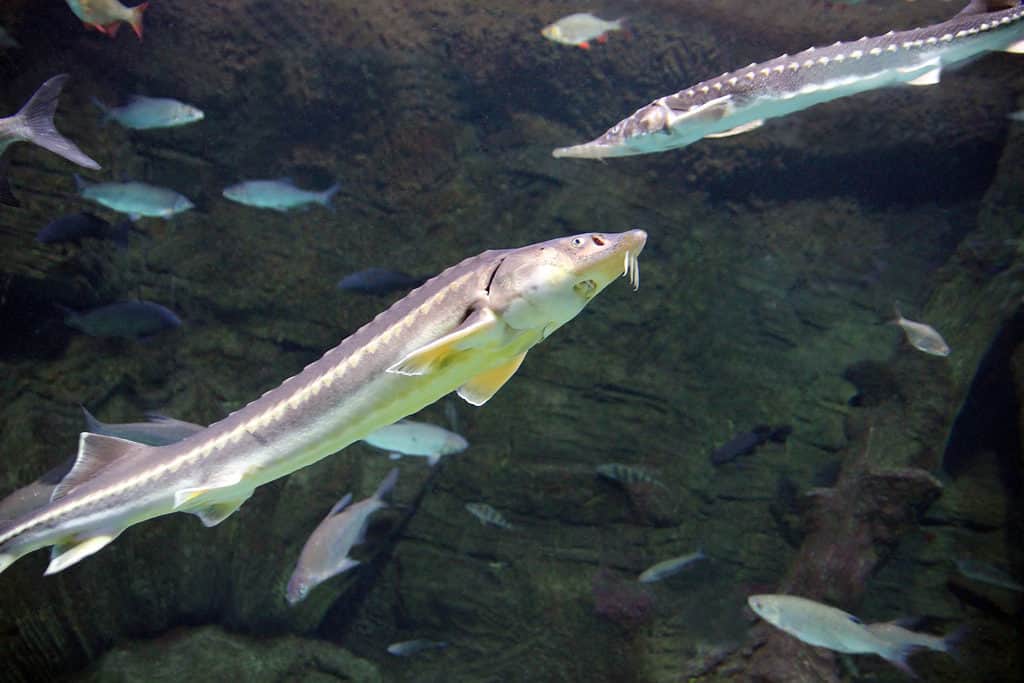
©iStock.com/OlgaRakhm
Final Thoughts
Conserving white sturgeon populations is vital for their survival, besides maintaining their habitats’ health. Unfortunately, habitat loss, overfishing, and other factors have caused a decline in white sturgeon populations in many areas.
Policymakers, anglers, and other stakeholders must team up to protect this endangered fish species. This can be realized through public education, conservation efforts, and regulations.
With proper conservation efforts, there is hope for this endangered fish and future angler generations.
Finally, as we celebrate the conservation successes, we must continue to conserve white sturgeon for future generations. With hope, the largest white sturgeon ever caught in California record could be broken in the future.
Up Next
- The Longest Hiking Trail in California
- The 7 Biggest Sharks Off California’s Coast
- The Largest Trees In California
The post Discover The Largest White Sturgeon Ever Caught in California appeared first on AZ Animals.
from Animal News, Facts, Rankings, and More! - AZ Animals https://ift.tt/a8cxhJn